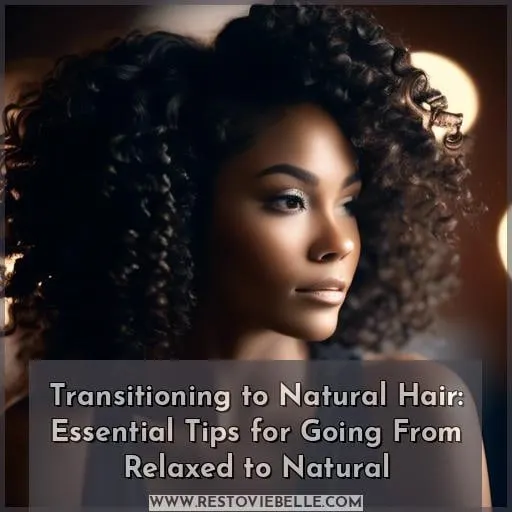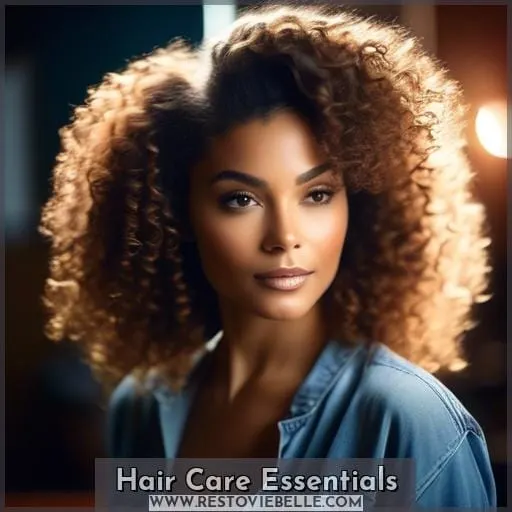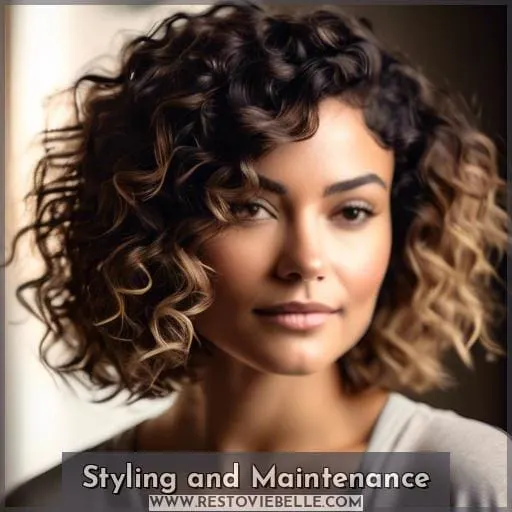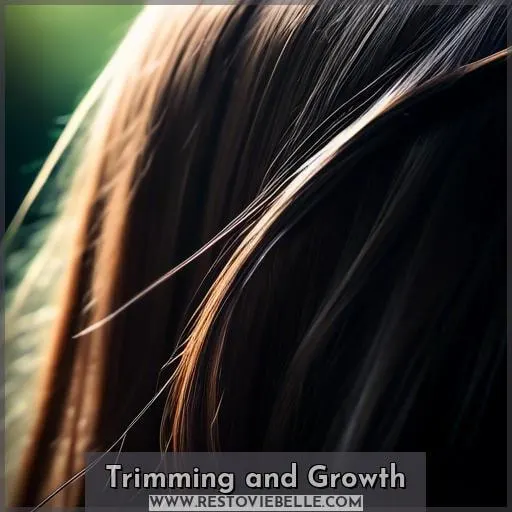This site is supported by our readers. We may earn a commission, at no cost to you, if you purchase through links.
 Embarking on the journey from relaxed to natural hair feels like unlocking a secret garden within you, where each curl and coil is a unique flower waiting to bloom.
Embarking on the journey from relaxed to natural hair feels like unlocking a secret garden within you, where each curl and coil is a unique flower waiting to bloom.
It’s a path paved with challenges, yet rich with rewards, as you rediscover the beauty of your natural texture.
This guide is your compass, offering essential tips to navigate the transition with grace. From embracing your curls to mastering moisture, we’ll guide you through shedding, styling, and everything in between.
Prepare to celebrate each step of your natural hair journey, as you grow closer to the most authentic version of yourself.
Table Of Contents
- Key Takeaways
- Understanding Transitioning
- Hair Care Essentials
- Shedding and Dryness
- Styling and Maintenance
- Trimming and Growth
- Health and Treatment
- Patience and Mindset
- Frequently Asked Questions (FAQs)
- How can I manage scalp sensitivity during the transition from relaxed to natural hair?
- Are there any specific vitamins or supplements that can aid in the health of transitioning hair?
- How do I handle social pressure or negative comments about my transitioning hair?
- Can swimming in chlorinated pools affect the health of transitioning hair, and how can I protect it?
- What are the best practices for sleeping with transitioning hair to minimize damage and maintain styles?
- Conclusion
Key Takeaways
- Embrace the natural texture of your hair and celebrate its uniqueness, avoiding comparisons with others and appreciating the beauty and versatility of your curls.
- Maintain the health of your hair by eliminating direct heat styling tools, deep conditioning weekly, and keeping your hair moisturized and hydrated with natural products.
- Adopt protective styling and gentle detangling techniques to minimize breakage and maintain hair health, especially at the line of demarcation between natural and relaxed hair.
- Be patient and committed to the process, understanding that increased shedding and dryness can occur during the transition, and regular scalp massages and trims can stimulate growth and improve scalp health.
Understanding Transitioning
Transitioning from relaxed to natural hair is a journey that requires patience, understanding, and a commitment to nurturing your hair through its various stages.
As you embark on this path, it’s essential to recognize the importance of the transitioning phase and embracing your natural texture. This process involves gradually moving away from chemical relaxers and learning to care for your new growth and existing relaxed ends in harmony.
By focusing on healthy hair care practices, such as regular trims, deep conditioning, and protective styling, you’ll support your hair’s strength and elasticity, making the transition smoother and more manageable.
Embracing your natural texture allows you to explore the unique beauty and versatility of your hair, fostering a deeper connection and appreciation for your authentic self.
The Transitioning Phase
During the transitioning phase from relaxed to natural hair, you’ll need to adjust your hair care routine to cater to both textures.
Embrace this time as an opportunity for healthy hair growth and to appreciate your hair’s natural texture.
Regular scalp massages can enhance blood flow, promoting stronger and healthier hair.
Adopt protective style maintenance to minimize heat damage and retain moisture.
Embracing Your Texture
In embracing your texture, you’re taking a crucial step towards appreciating the unique beauty of your natural hair.
- Celebrate your curl pattern’s uniqueness, seeing it as a reflection of your identity.
- Use natural hair products that enhance curl definition and health.
- Embrace texture acceptance as a form of self-love.
- Recognize every stage of your natural hair journey as progress towards texture appreciation.
Hair Care Essentials
Transitioning from relaxed to natural hair is a journey that requires a shift in your hair care routine to ensure healthy growth and minimize damage.
To start, it’s crucial to eliminate direct heat from styling tools like flat irons and blow dryers, as excessive heat can further damage transitioning hair. Instead, opt for air drying or use hooded dryers on a low setting for a limited time.
Deep conditioning on a weekly basis is another essential step; it helps to strengthen both the new growth and the relaxed ends, improving overall hair texture and manageability.
Moisture and hydration are key to maintaining elasticity and preventing breakage during this period. Incorporating products that deeply nourish and hydrate, such as the ORS Olive Oil Conditioner, can make a significant difference in the health of your transitioning hair.
Eliminate Direct Heat
One should avoid direct heat styling tools such as flat irons and blow dryers to protect transitioning hair from further damage. This step reduces scalp damage and cuts down on appliance dependence, encouraging air drying for better styling flexibility.
Embracing this change enhances hair health, marking a pivotal moment in your journey from relaxed to natural. It’s a crucial part of going natural, fostering a sense of liberation and belonging.
Deep Condition Weekly
For optimal hair health during your transition, you’ll need to deep condition your locks weekly, using products that cater to both your natural and relaxed textures.
- Explore deep conditioning masks that offer intense moisture and repair.
- Try homemade deep conditioners for a personalized touch.
- Research the best deep conditioners for your hair type.
- Incorporate deep conditioning treatments to enhance scalp health and support natural curls under protective styles.
Moisture and Hydration
Continuing from deep conditioning, you’ll find that maintaining moisture and hydration is crucial for your hair’s health and elasticity during the transition. Embrace hydration techniques and moisturizing products that cater to your evolving texture, including leave-in conditioners and penetrating oils, to support your journey of going natural from relaxed hair.
| Hydration Product | Benefit |
|---|---|
| Leave-in Conditioners | Seals moisture, detangles |
| Penetrating Oils | Nourishes, strengthens |
| Deep Conditioning Treatments | Restores elasticity, prevents breakage |
| Moisturizing Sprays | Refreshes, maintains hydration |
Shedding and Dryness
When transitioning from relaxed to natural hair, it’s common to experience increased shedding and dryness.
This phase requires a focus on scalp health to encourage hair growth and reduce breakage.
Regularly moisturizing your scalp and hair, avoiding harsh ingredients, and being gentle during detangling can help manage these challenges effectively.
Managing Increased Shedding
As you continue to nurture your transitioning hair, it’s important to address the increased shedding that often accompanies this process.
You’ll typically notice more hair fall due to the fragile state of the line of demarcation, where your natural texture meets the relaxed ends.
To manage this, avoid harsh ingredients like sulfates and alcohol, which can exacerbate dryness and breakage, and instead focus on maintaining scalp health with gentle, moisturizing products like Wash Day Delight shampoo.
Regular scalp massages can also stimulate blood flow and support hair health, while being gentle when detangling with a wide-tooth comb can minimize unnecessary stress on your strands.
Scalp Health Focus
Your scalp’s health is pivotal in managing shedding and dryness during the transition from relaxed to natural hair; it’s essential to keep it nourished and free from irritants that can exacerbate these conditions.
- Avoid products that cause scalp irritation, opting for gentle, sulfate-free options.
- Alleviate scalp sensitivity and dryness with regular scalp massages using nourishing oils.
- Incorporate scalp exfoliation into your routine to remove buildup and promote healthy hair growth.
Styling and Maintenance
After addressing the challenges of shedding and dryness, it’s essential to focus on styling and maintenance, which involves adopting techniques that minimize damage while promoting hair health. Embrace protective styles that safeguard your strands from daily wear and tear. When detangling, use techniques that are gentle on your tresses, such as starting from the ends and working your way up with a wide-tooth comb.
Seek out product recommendations tailored to your hair’s unique needs, ensuring you’re using the best formulas for moisture and strength. Don’t forget to accessorize smartly; hair accessories should be snag-free to prevent breakage.
Follow these styling tips to maintain your hair’s integrity during the transition.
| Protective Styles | Detangling Techniques | Product Recommendations |
|---|---|---|
| Twists and Braids | Wide-tooth comb | Sulfate-free Shampoo |
| Satin-lined Caps | Start from the ends | Deep Conditioners |
| Low Manipulation | Use detangling sprays | Leave-in Conditioners |
| Loose Updos | Finger detangling | Hair Oils |
Trimming and Growth
When transitioning from relaxed to natural hair, it’s essential to establish a regular trimming schedule to encourage healthy hair growth.
Trimming your hair every 6-8 weeks can help speed up the transition by removing damaged ends and preventing further breakage.
This gradual approach allows you to maintain length while your natural texture grows in, ultimately leading to stronger, healthier hair.
Regular Trimming Schedule
Maintaining your hair’s health during the transition from relaxed to natural requires a regular trimming schedule to manage split ends and encourage growth.
Trimming every 6-8 weeks helps in breakage prevention, ensuring your hair retains length.
It also enhances protective styles and styling versatility, making your journey to natural hair not just about growth, but about maintaining strong, healthy locks.
Encouraging Hair Growth
To encourage hair growth during your transition, you’ll need to nurture both your new natural texture and the older relaxed ends.
- Adopt a vitamin regimen to support healthy hair from within.
- Focus on hair length retention by minimizing breakage with low manipulation techniques.
- Establish a daily hair care routine that includes gentle handling and moisturizing.
- Incorporate growth-promoting foods into your diet for optimal hair health.
Health and Treatment
As you transition from relaxed to natural hair, it’s essential to focus on the health and treatment of both your hair and scalp.
Incorporating scalp massages and hot oil treatments into your routine can significantly improve scalp circulation and hair strength. These practices not only soothe and nourish your scalp but also promote healthier hair growth during your natural hair journey.
Importance of Scalp Massage
In the midst of your hair care routine, incorporating scalp massages can significantly enhance the health of your hair by stimulating blood flow to the follicles and promoting growth.
Regular scalp massage benefits include improved circulation and nutrient delivery.
Opt for nourishing oils to maximize the effects and support your journey to natural, vibrant hair.
Hot Oil Treatments
Following scalp massage, hot oil treatments are another crucial step in your hair care routine, offering deep nourishment and strengthening benefits.
- Selecting hair oils that match your hair’s needs, such as coconut for dry hair or jojoba for quick absorption.
- Performing a DIY hot oil treatment, ensuring the oil is warm but not too hot to prevent scalp burns.
- Determining the frequency of treatment, which can be as often as once a week for dry hair types.
- Recognizing the improvement in scalp health and overall hair condition, including reduced dryness and breakage.
Hot oil treatments work by sealing the hair cuticle, which can strengthen and protect your hair. It’s important to use natural oils and to test the oil temperature before application to avoid any adverse reactions, especially if you have sensitive skin.
Patience and Mindset
Transitioning to natural hair from relaxed hair requires patience and a flexible mindset.
Setting realistic expectations and celebrating the journey are essential.
Experiment with different protective styles.
Focus on scalp health.
Use the right products to maintain healthy hair during the transition.
Setting Realistic Expectations
Understanding the importance of scalp massage and hot oil treatments sets the stage for recognizing that transitioning to natural hair is a journey that requires you to set realistic expectations and maintain a patient mindset.
Embrace flexibility, set realistic milestones, and avoid comparisons. Celebrate your hair’s slow progress and uniqueness. This mindset fosters a sense of belonging and understanding in your natural hair journey.
Celebrating Natural Hair Journey
Your journey’s success hinges on embracing each step with patience and a positive mindset, recognizing that every phase brings you closer to your natural hair goals.
Celebrate your natural hair pride and the cultural significance of your curls.
Cultivate a self-care routine that honors your individuality.
Lean on community support for encouragement and shared wisdom, as you transform and reclaim the essence of your unique beauty.
Frequently Asked Questions (FAQs)
How can I manage scalp sensitivity during the transition from relaxed to natural hair?
To manage scalp sensitivity while transitioning from relaxed to natural hair, follow these steps:
Use gentle, sulfate-free shampoos like Wash Day Delight.
Deep condition your hair regularly.
Apply soothing oils such as lavender or peppermint.
Avoid tight hairstyles to reduce tension.
Are there any specific vitamins or supplements that can aid in the health of transitioning hair?
Certain vitamins, like biotin and vitamins D, E, and B complex, can support the health of transitioning hair by improving scalp health and hair strength.
Always consult a healthcare professional before starting any supplements.
How do I handle social pressure or negative comments about my transitioning hair?
Facing social pressure or negative comments about transitioning hair can be tough, but remember, 80% of women who embrace their natural hair texture report feeling more authentic and liberated.
When confronted with negativity, confidently express that your hair choice reflects your personal journey and heritage, emphasizing the beauty and strength in diversity.
Engage in communities that celebrate natural hair for support and inspiration, and always prioritize your self-esteem and happiness over others’ opinions.
Can swimming in chlorinated pools affect the health of transitioning hair, and how can I protect it?
Yes, swimming in chlorinated pools can affect the health of transitioning hair by stripping it of natural oils, making it dry and brittle.
To protect your hair, wet and coat it with conditioner or coconut oil before swimming to prevent chlorine absorption.
After swimming, use a chlorine-fighting shampoo and deep condition to restore moisture.
What are the best practices for sleeping with transitioning hair to minimize damage and maintain styles?
As if by chance, you’ll find that wrapping your transitioning hair in a satin or silk scarf or bonnet at night mirrors the gentle embrace of sleep, safeguarding your strands from breakage and preserving your style’s grace.
Conclusion
Embrace, moisturize, trim, and celebrate—these are your mantras as you transition from relaxed to natural hair.
By nurturing your curls and maintaining a healthy scalp, you’re not just changing your hairstyle, you’re embracing a lifestyle.
Stay committed, and soon you’ll revel in the full glory of your natural, radiant tresses.












